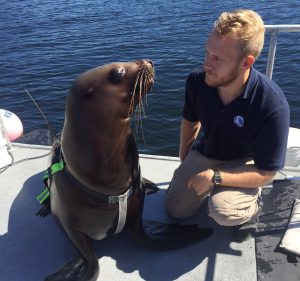Tel: 604.822.8181
Fax: 604.822.8180
E-mail: a.purdy@oceans.ubc.ca
Supervisors: Drs Anthony P. Farrell and David Rosen
Education: BSc. Zoology and Anthropology, University of Calgary, Canada
Research Interests: Ecological physiology, animal behaviour and physiology, conservation biology
Research Area: North Pacific Ocean, Alaska, and British Columbia
What are the physiological effects of increased foraging effort in Steller sea lions (Eumetopias jubatas)?
Background
Since the 1970s, the western populations of Steller sea lions have seen drastic declines with certain populations decreasing by more than 75% since 1980. While the cause of this decline is unknown, one of the leading theories proposes changes in prey type and availability may have hindered the ability of sea lion populations to meet daily energetic demands. This has been deemed the nutritional stress hypothesis, and would help to explain the population declines and their lack of recovery. To fully test this hypothesis, it is key that we understand the physiological capacity of sea lions to forage. This will help us to assess how efficiently sea lion populations are meeting their energetic requirements.
Like all breath-holding divers, foraging in Steller sea lions is limited by their aerobic dive limit (ADL): the duration an animal can remain submerged using only aerobic metabolism. Diving past this point will result in as switch to anaerobic metabolism, an energetically inefficient strategy resulting in an accumulation of lactate in the body. As diving past this limit will hinder an individual’s foraging capacity, understanding the physiological consequences associated with it is essential. One possible cost to diving past the ADL is an increase in recovery time.
Research Questions
Through my research, I wish to answer the following questions:
- How does gas balance (O2 and CO2) recovery time change with increased dive effort?
- What is the aerobic dive limit of Steller sea lions?
Approach
I am conducting my research at the UBC’s Open Water Research Laboratory. Here, I work with four adult Steller sea lions which are trained to dive in the open ocean to relative foraging depths. Here we can supply them with food through feeding tubes, allowing us to mimic a foraging dive. The sea lions are then trained to surface underneath a flow-through respirometry dome where we can measure oxygen consumption and carbon dioxide production. This allows us to determine how long it takes to return to resting metabolic levels after surfacing. We can manipulate foraging effort by increasing their dive time, as well as by increasing their drag by attaching high surface area material to their harnesses. Dive behaviour is recorded through time-depth recorders, and accelerometry.
In addition to this, sea lions are trained to surface onto a working platform. Here we can obtain voluntary blood samples immediately after their dives, allowing us to measure their lactate levels and therefore determine their ADL. By comparing this to the recovery data, we can examine the effects of diving past this physiological constraint.

